Themed collection Reactions Facilitated by Ligand Design

Reactions facilitated by ligand design
Welcome to this themed issue of Dalton Transactions entitled “Reactions facilitated by ligand design”.

Dalton Trans., 2016,45, 15700-15701
https://doi.org/10.1039/C6DT90177H
Metal–ligand cooperation at tethered π-ligands
Recent advances in the use of tethered π-coordinating ligands for metal–ligand cooperation.
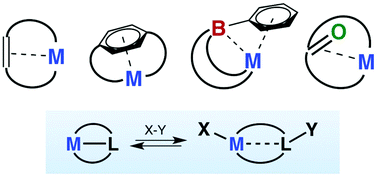
Dalton Trans., 2016,45, 15762-15778
https://doi.org/10.1039/C6DT02184K
Group 5 chemistry supported by β-diketiminate ligands
β-Diketiminate (BDI) ligands are widely used supporting ligands in modern organometallic chemistry and are capable of stabilizing various metal complexes in multiple oxidation states and coordination environments.

Dalton Trans., 2016,45, 15725-15745
https://doi.org/10.1039/C6DT01770C
The ligand influence in stereoselective carbene transfer reactions promoted by chiral metal porphyrin catalysts
This Perspective illustrates the state-of-the-art of stereoselective carbene transfer reactions catalysed by chiral metal porphyrin complexes. A particular attention is focused on the active role of the porphyrin ligand to drive the carbene insertion into the target organic skeleton.

Dalton Trans., 2016,45, 15746-15761
https://doi.org/10.1039/C6DT02094A
Current advances in ligand design for inorganic positron emission tomography tracers 68Ga, 64Cu, 89Zr and 44Sc
A key part of the development of metal based Positron Emission Tomography probes is the chelation of the radiometal.

Dalton Trans., 2016,45, 15702-15724
https://doi.org/10.1039/C5DT04706D
Boosting catalyst activity in cis-selective semi-reduction of internal alkynes by tailoring the assembly of all-metal aromatic tri-palladium complexes
Zwitterionic all-metal aromatic tri-palladium complexes can catalyse the cis-selective semi-reduction of internal alkynes at ppm levels.

Dalton Trans., 2016,45, 15786-15790
https://doi.org/10.1039/C6DT01840H
Carbon dioxide cleavage across a tungsten-alkylidyne bearing a trianionic pincer-type ligand
Splitting of CO2 across the tungsten-carbon triple bond in [CF3-ONO]W![[triple bond, length as m-dash]](https://www.rsc.org/images/entities/char_e002.gif) CCtBu(THF)2 (1) yields the tungsten oxo ketene [CF3-ONO]W(O){(CH3)3CC
CCtBu(THF)2 (1) yields the tungsten oxo ketene [CF3-ONO]W(O){(CH3)3CC![[double bond, length as m-dash]](https://www.rsc.org/images/entities/char_e001.gif) C
C![[double bond, length as m-dash]](https://www.rsc.org/images/entities/char_e001.gif) O} (6).
O} (6).

Dalton Trans., 2016,45, 15783-15785
https://doi.org/10.1039/C6DT01049K
A multimetallic iron(II)–lithium complex as a catalyst for ε-caprolactone polymerization
Treatment of the lithium salt of β-ketimine with FeCl2(THF)1.5 in the presence of LiN(SiMe3)2 and water affords the multimetallic iron(II)–lithium complex 1, [(LMe)2Fe]3Li2O [where LMe = MeC(O)CHC(NMe)Me].

Dalton Trans., 2016,45, 15779-15782
https://doi.org/10.1039/C6DT00078A
Copper catalysed aerobic oxidation of benzylic alcohols in an imidazole containing N4 ligand framework
The catalytic aerobic oxidation of benzylic alcohols to corresponding aldehydes has been investigated employing a tetradentate copper(II) complex that incorporates N-methyl imidazole (NMI) as an integral part of an N4-ligand framework.
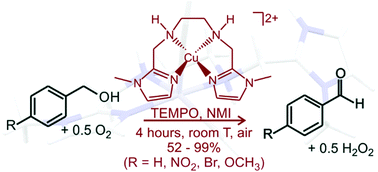
Dalton Trans., 2016,45, 18356-18364
https://doi.org/10.1039/C6DT03395D
Synthesis of six-coordinate mono-, bis-, and tris(tetrazolato) complexes via [3 + 2] cycloadditions of nitriles to silicon-bound azido ligands
The unusual situation presented by a silicon centre coordinating four 1,3-dipolar ligands is exploited in thermally activated cycloaddition reactions with nitriles that lead to six-coordinate poly(tetrazolato) complexes of silicon.
![Graphical abstract: Synthesis of six-coordinate mono-, bis-, and tris(tetrazolato) complexes via [3 + 2] cycloadditions of nitriles to silicon-bound azido ligands](/en/Image/Get?imageInfo.ImageType=GA&imageInfo.ImageIdentifier.ManuscriptID=C6DT02867E&imageInfo.ImageIdentifier.Year=2016)
Dalton Trans., 2016,45, 17141-17152
https://doi.org/10.1039/C6DT02867E
Dinuclear uranium complexation and manipulation using robust tetraaryloxides
Two lower-oxidation state uranium cations can be readily combined and controlled in a robust and derivatisable tetra-aryloxide ligand framework. These di-UIII/IV systems are a new platform at which to use the multi-electron reductive capacity of the two actinide centres.

Dalton Trans., 2016,45, 16026-16032
https://doi.org/10.1039/C6DT02630C
Metal–ligand cooperative activation of nitriles by a ruthenium complex with a de-aromatized PNN pincer ligand
Metal–ligand cooperative activation of nitriles by a de-aromatized Ru pincer complex leads to equilibrium mixtures (tautomers) as a result of ligand deprotonation by the Brønsted basic Ru-ketimido moiety.

Dalton Trans., 2016,45, 16033-16039
https://doi.org/10.1039/C6DT02478E
Coordination versatility of p-hydroquinone-functionalized dibenzobarrelene-based PC(sp3)P pincer ligands
Bifunctional hydroquinone-based PC(sp3)P pincer complexes.
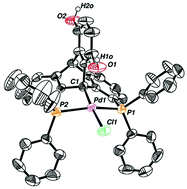
Dalton Trans., 2016,45, 16040-16046
https://doi.org/10.1039/C6DT02201D
Synthesis of a sterically bulky diphosphine synthon and Ru(II) complexes of a cooperative tridentate enamide-diphosphine ligand platform
The preparation of the bulky diphosphine synthon 1 is described and used to generate a tridentate enamido diphosphine ligand platform that can be installed on Ru(II).

Dalton Trans., 2016,45, 16011-16025
https://doi.org/10.1039/C6DT02352E
The control of the electronic structure of dinuclear copper complexes of redox-active tetrakisguanidine ligands by the environment
The electronic structures of dinuclear copper complexes of the general formula [GFA(CuX2)2], where X = Br or Cl and GFA denotes a redox-active bridging Guanidino-Functionalized Aromatic ligand, were analysed and compared.
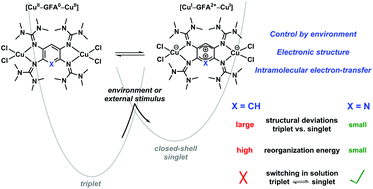
Dalton Trans., 2016,45, 15828-15839
https://doi.org/10.1039/C6DT02128J
Changing the chemical and physical properties of high valent heterobimetallic bis-(μ-oxido) Cu–Ni complexes by ligand effects
Two new heterobimetallic [LNiO2Cu(RPY2)]+ (RPY2 = N-substituted bis 2-pyridyl(ethylamine) ligands with R = indane, 3a or R = Me, 3b) complexes have been spectroscopically trapped at low temperatures.
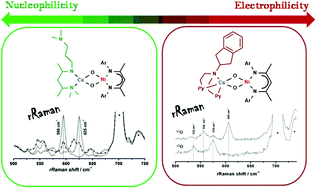
Dalton Trans., 2016,45, 15994-16000
https://doi.org/10.1039/C6DT02391F
Bimetallic salen aluminum complexes: cooperation between reactive centers in the ring-opening polymerization of lactides and epoxides
In dinuclear aluminum complexes, opportunely designed to have proximal coordinative pockets, the communication between the two reactive centers allows enhanced catalytic performances.
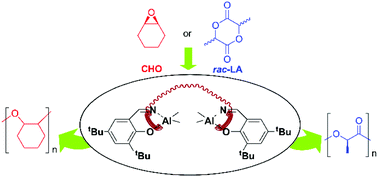
Dalton Trans., 2016,45, 16001-16010
https://doi.org/10.1039/C6DT02592G
Chelating N-heterocyclic carbene–carboranes offer flexible ligand coordination to IrIII, RhIII and RuII: effect of ligand cyclometallation in catalytic transfer hydrogenation
NHC–carborane ligands, with flexible coordination through either the carbon or the boron atom of the carborane, provide effective transfer hydrogenation catalysts.
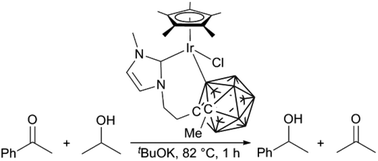
Dalton Trans., 2016,45, 15818-15827
https://doi.org/10.1039/C6DT02079H
On the mechanism of Ni(II)-promoted Michael-type hydroamination of acrylonitrile and its substituted derivatives
Monocationic Ni(II) complexes featuring variously substituted POCOP-type pincer ligands promote the addition of primary amines to crotonitrile, methacrylonitrile, and cinnamonitrile.

Dalton Trans., 2016,45, 15800-15810
https://doi.org/10.1039/C6DT02105K
RuII, IrIII and OsII mesoionic carbene complexes: efficient catalysts for transfer hydrogenation of selected functionalities
Pyridine- and pyrimidine-appended triazolylidene donors are used as ligands for the transfer hydrogenation of a series of functionalities.
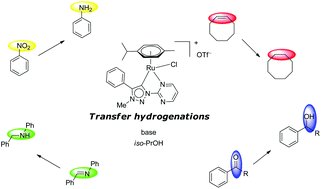
Dalton Trans., 2016,45, 15983-15993
https://doi.org/10.1039/C6DT01324D
Interrogating heterobimetallic co-catalytic responses for the electrocatalytic reduction of CO2 using supramolecular assembly
The use of hydrogen-bonding interactions to direct the non-covalent assembly of a heterobimetallic supramolecular system with Re and Mn bipyridine-based electrocatalysts is reported.

Dalton Trans., 2016,45, 15942-15950
https://doi.org/10.1039/C6DT01956K
Aluminum complexes containing biphenolate phosphine ligands: synthesis and living ring-opening polymerization catalysis
The first examples of aluminum complexes containing biphenolate phosphine ligands are prepared, structurally characterized, and demonstrated to have catalytic competence in the living ring-opening (co)polymerization of ε-caprolactone and rac-lactide.
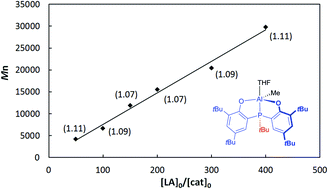
Dalton Trans., 2016,45, 15951-15962
https://doi.org/10.1039/C6DT02143C
An electron poor iridium pincer complex for catalytic alkane dehydrogenation
A new electron deficient iridium complex demonstrates an improved TON in alkane transfer dehydrogenation reactions compared to similar pre-catalysts.

Dalton Trans., 2016,45, 15963-15969
https://doi.org/10.1039/C6DT01816E
Thermodynamics of N–H bond formation in bis(phosphine) molybdenum(II) diazenides and the influence of the trans ligand
Dinitrogen-derived molybdenum alkyldiazenides and alkylhydrazides were synthesized with various trans ligands. The thermodynamics of N–H bond formation were studied both experimentally and computationally.
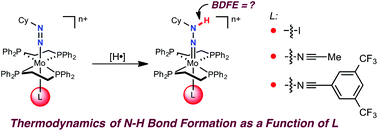
Dalton Trans., 2016,45, 15922-15930
https://doi.org/10.1039/C6DT01932C
Controlling uranyl oxo group interactions to group 14 elements using polypyrrolic Schiff-base macrocyclic ligands
Interactions between the uranyl oxo atom and group 14 metal cations in macrocyclic Pacman complexes depend on both molecular cleft constraints and the fifth equatorial ligand of the uranyl.
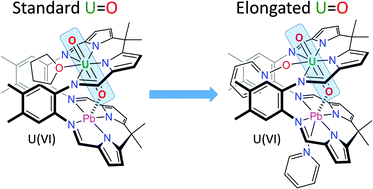
Dalton Trans., 2016,45, 15902-15909
https://doi.org/10.1039/C6DT01948J
Relativistic DFT and experimental studies of mono- and bis-actinyl complexes of an expanded Schiff-base polypyrrole macrocycle
Relativistic DFT calculations present accurate geometries of complexes and redox properties, confirmed by the newly-developed experimental syntheses.
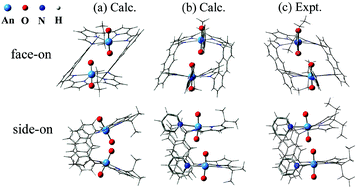
Dalton Trans., 2016,45, 15910-15921
https://doi.org/10.1039/C6DT01625A
Theoretical investigation of low-valent uranium and transuranium complexes of a flexible small-cavity macrocycle: structural, formation reaction and redox properties
Size matching of a flexible macrocycle with low-valent actinide(III/IV) ions as well as their bonding determines different coordination modes.
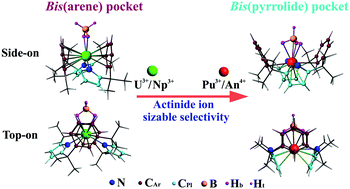
Dalton Trans., 2016,45, 15970-15982
https://doi.org/10.1039/C6DT01930G
A long-tethered (P–B–P)-pincer ligand: synthesis, complexation, and application to catalytic dehydrogenation of alkanes
A new long-tethered boron-containing (P–B–P)-pincer ligand has been synthesized. This ligand was introduced to Ir to form (P–B–P)Ir(H)Cl complex. Subsequent reaction with nBuLi led to the formation of dihydride complex (P–B–P)Ir(H)2. Both complexes were found to be moderately active for the catalytic dehydrogenation of alkanes.

Dalton Trans., 2016,45, 15931-15941
https://doi.org/10.1039/C6DT02075E
Synthesis and reactions of a zirconium naphthalene complex bearing a tetraanionic C-capped triaryloxide ligand
A zirconium naphthalene complex containing a C-capped triaryloxide ligand, which can act as a Zr(II) synthon, was synthesized and fully characterized.

Dalton Trans., 2016,45, 15879-15885
https://doi.org/10.1039/C6DT01848C
Reversible methanol addition to copper Schiff base complexes: a kinetic, structural and spectroscopic study of reactions at azomethine C![[double bond, length as m-dash]](https://www.rsc.org/images/entities/char_e001.gif) N bonds
N bonds
The reversible ligand-directed methanolysis of a series of copper(II) Schiff base complexes reveal slightly favorable equilibrium constants with addition and eliminations rates influenced by the identity of the axial ligand.
![Graphical abstract: Reversible methanol addition to copper Schiff base complexes: a kinetic, structural and spectroscopic study of reactions at azomethine C [[double bond, length as m-dash]] N bonds](/en/Image/Get?imageInfo.ImageType=GA&imageInfo.ImageIdentifier.ManuscriptID=C6DT01955B&imageInfo.ImageIdentifier.Year=2016)
Dalton Trans., 2016,45, 15791-15799
https://doi.org/10.1039/C6DT01955B
The influence of the ligand chelate effect on iron-amine-catalysed Kumada cross-coupling
The performance of Fe-amine pre-catalysts in a representative Kumada reaction is inversely proportional to the lability of the chelate ligand.

Dalton Trans., 2016,45, 15811-15817
https://doi.org/10.1039/C6DT01823H
Ligand effects on the properties of Ni(III) complexes: aerobically-induced aromatic cyanation at room temperature
Ligand effect studies on (RN3C)NiIIIL2 complexes reveal aerobically-induced aromatic cyanation with tBuNC at room temperature for the (NpN3C)Ni system.
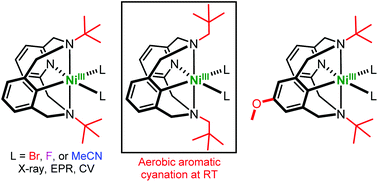
Dalton Trans., 2016,45, 15886-15893
https://doi.org/10.1039/C6DT02185A
Unexpected reactivity of an alkylaluminum complex of a non-innocent 1,2-bis[(2,6-diisopropylphenyl)imino]acenaphthene ligand (dpp-bian)
The non-innocence of the bis-amido dpp-bian ligand has been documented by the reactions of compound 1 with acidic substrates, e.g. water.
![Graphical abstract: Unexpected reactivity of an alkylaluminum complex of a non-innocent 1,2-bis[(2,6-diisopropylphenyl)imino]acenaphthene ligand (dpp-bian)](/en/Image/Get?imageInfo.ImageType=GA&imageInfo.ImageIdentifier.ManuscriptID=C6DT01750A&imageInfo.ImageIdentifier.Year=2016)
Dalton Trans., 2016,45, 15872-15878
https://doi.org/10.1039/C6DT01750A
Metallo-Wittig chemistry of an alkylidene to form a terminal titanium oxo complex
The synthesis and characterization of a terminal titanium oxo complex generated by alkylidene benzophenone cross-metathesis is reported.
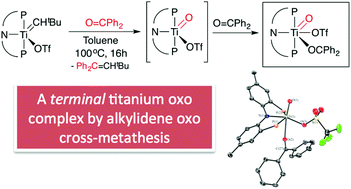
Dalton Trans., 2016,45, 15894-15901
https://doi.org/10.1039/C6DT01534D
Synthesis and characterization of five-coordinate, 16-electron RuII complexes supported by tridentate bis(phosphino)silyl ligation
New electronically and coordinatively unsaturated complexes of the type (Cy-PSiP)RuX(L) (Cy-PSiP = κ3-(2-Cy2PC6H4)2SiMe) are reported, including examples of 16-electron allyl and azido Ru species.
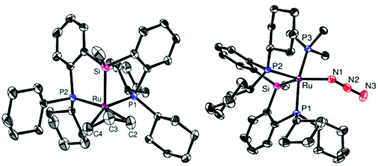
Dalton Trans., 2016,45, 15850-15858
https://doi.org/10.1039/C6DT01869F
Versatile bonding and coordination modes of ditriazolylidene ligands in rhodium(III) and iridium(III) complexes
Metalation of novel ditriazolium salts containing a trimethylene (–CH2CH2CH2–) or dimethylether linker (–CH2OCH2–) was probed with different rhodium(III) and iridium(III) precursors.
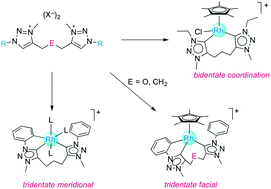
Dalton Trans., 2016,45, 15859-15871
https://doi.org/10.1039/C6DT01760F
Iron(II) β-ketiminate complexes as mediators of controlled radical polymerisation
A series of novel iron(II) β-ketiminate complexes have been prepared and screened in styrene and methyl methacrylate CRP.

Dalton Trans., 2016,45, 15840-15849
https://doi.org/10.1039/C6DT01208F
About this collection
This issue focusses on transformations involving inorganic complexes where a ligand design approach has been used to produce a demonstrable change in reactivity. The collection includes papers across inorganic or organometallic chemistry, including catalysis, small molecule activation, C–X bond activation, bioinorganic chemistry and supramolecular chemistry. Ligand classes include pincers, carbenes, macrocyclic ligands, phosphines or metallocenes, and approaches for goal-oriented ligand design involving aspects such as redox non-innocence, steric hindrance, secondary coordination sphere effects and manipulation of Lewis pairs.